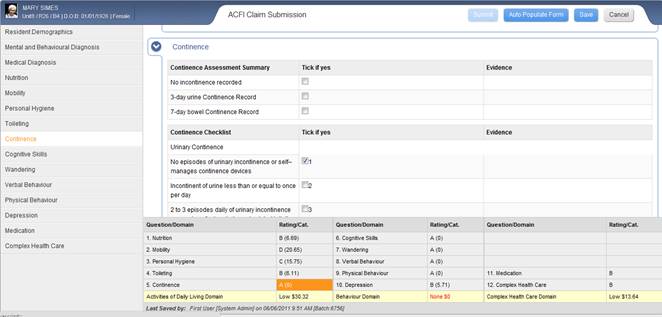

The checklist is populated from the below areas in the Continence Assessment – post 3-4 Day Assessment.
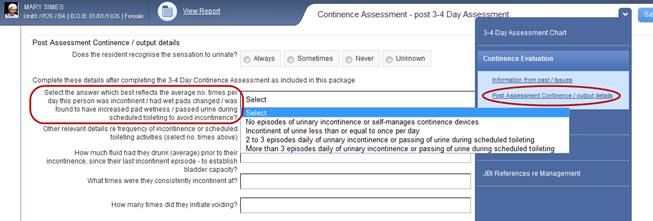
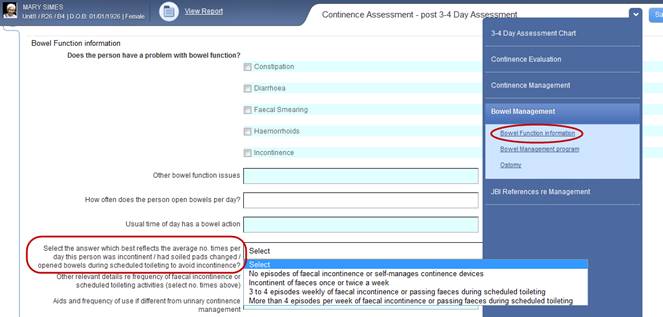
Urinary Continence
The Continence Assessment – post 3-4 Day Assessment should be used in conjunction with a minimum three-day urinary continence assessment in order to meet the requirements of the ACFI 5 Continence Question. The Continence Assessment – post 3-4 Day Assessment form is used to summarise the findings of the 3-day urinary assessment period to document identified, assessment based, care management strategies.
Staff complete the Continence Assessment Daily Form for three days.
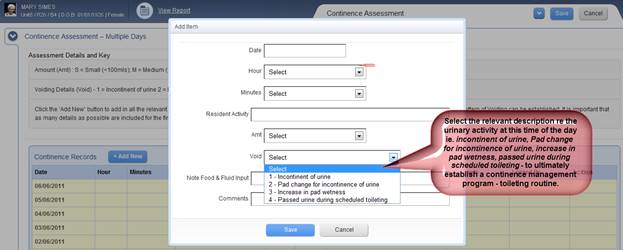
Users must select the relevant description re the urinary activity at the time of the day to ultimately establish a continence management program – toileting routine i.e.:
o the resident was ‘incontinent of urine’
o they had a ‘Pad change for incontinence of urine’
o there was an ‘increase in pad wetness’
o the resident ‘passed urine during scheduled toileting’
Users must also record by selecting the relevant drop-down choice:
o the urine Amount voided at this time
o the resident’s activity to establish if they voided during a resting period or whilst undertaking activity (to determine the type of incontinence the resident experiences)
o any food or fluid input to establish the bladder’s volume capacity and length of time the bladder is able to hold fluids to plan toileting times from.
The summary / analysis of these findings should be entered the Continence assessment – post 3-4 Day Assessment including any scheduled toileting times.
Bowel Management
The Continence Assessment – post 3-4 Day Assessment should be used in conjunction with a minimum seven-day urinary continence assessment to meet the requirements of the ACFI 5 Continence Question. The Continence Assessment – post 3-4 Day Assessment form is used to summarise the findings of the seven-day bowel assessment period to document identified, assessment based, care management strategies.
Staff must record bowel activity and bowel management outcomes for a minimum seven days using the Bowel Chart.
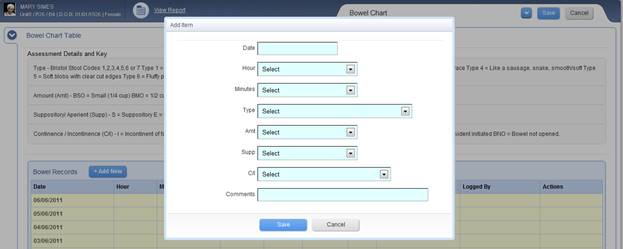
The Bristol Stool score tool is present as a drop-down selection of Type, as is the Amount of motion, the continence status of the bowel activity, the use of aperient details and the time of the motion. The following outlines what choices are available:
o Users must select the relevant bowel motion amount using the Key as a guide – BSO, BMO, BWO.
o If an aperient was used at or around the noted time, users must select Suppository, Enema, Aperient, or Stool Softener.
o Users must select the most accurate description of the bowel motion, i.e. whether the resident was at this time I= incontinent of faeces, P = pad changed due to incontinence of faeces, ST = bowels opened during scheduled toileting, RI = resident initiated, BNO = bowels not opened
The summary / analysis of these findings should be entered into the Continence assessment – post 3-4 Day Assessment including any scheduled toileting times.
Note: The mandated ‘ACFI 5 Continence – Assessment’ Report (available via Reports / ACFI) will be auto-populated with data from the Continence Assessment and Bowel Chart (Daily Form). (Please refer to the ACFI Reports section of this user manual for further details).
The table below displays the Assessment details linked to the ACFI Claim Submission in the Continence Checklist.
|
Continence Checklist |
Assessment(s) |
Question(s) |
Response(s) |
|
1.Urinary continence |
|
|
|
|
1 |
Continence Assessment – post 3-4-day Assessment |
Select the answer which best reflects the average no. times per day this person was incontinent / had wet pads changed / was found to have increased pad wetness / passed urine during scheduled toileting to avoid incontinence |
No episodes of urinary incontinence or self-manages continence devices |
|
2 |
Continence Assessment – post 3-4-day Assessment |
Select the answer which best reflects the average no. times per day this person was incontinent / had wet pads changed / was found to have increased pad wetness / passed urine during scheduled toileting to avoid incontinence |
Incontinent of urine less than or equal to once per day |
|
3 |
Continence Assessment – post 3-4-day Assessment |
Select the answer which best reflects the average no. times per day this person was incontinent / had wet pads changed / was found to have increased pad wetness / passed urine during scheduled toileting to avoid incontinence |
2 to 3 episodes daily of urinary incontinence or passing of urine during scheduled toileting
|
|
4 |
Continence Assessment – post 3-4-day Assessment |
Select the answer which best reflects the average no. times per day this person was incontinent / had wet pads changed / was found to have increased pad wetness / passed urine during scheduled toileting to avoid incontinence |
More than 3 episodes daily of urinary incontinence or passing of urine during scheduled toileting |
|
2.Faecal continence |
|
|
|
|
5 |
Continence Assessment – post 3-4-day Assessment |
Select the answer which best reflects the average no. times per day this person was incontinent / had soiled pads changed / opened bowels during scheduled toileting to avoid incontinence
|
No episodes of faecal incontinence or self-manages continence devices |
|
6 |
Continence Assessment – post 3-4-day Assessment |
Select the answer which best reflects the average no. times per day this person was incontinent / had soiled pads changed / opened bowels during scheduled toileting to avoid incontinence |
Incontinent of faeces once or twice a week |
|
7 |
Continence Assessment – post 3-4-day Assessment |
Select the answer ich best flec the average no. times per day this personas iontinent / had soiled pads changed / opened bowels during scheduled toileting to avoid incontinence |
3 to 4 episodes weekly of faecal incontinence or passing faeces during scheduled toileting |
|
8 |
Continence Assessment – post 3-4-day Assessment |
Select the answer which best reflects the average no. times per day this person was incontinent / had soiled pads changed / opened bowels during scheduled toileting to avoid incontinence |
More than 4 episodes per week of faecal incontinence or passing faeces during scheduled toileting |